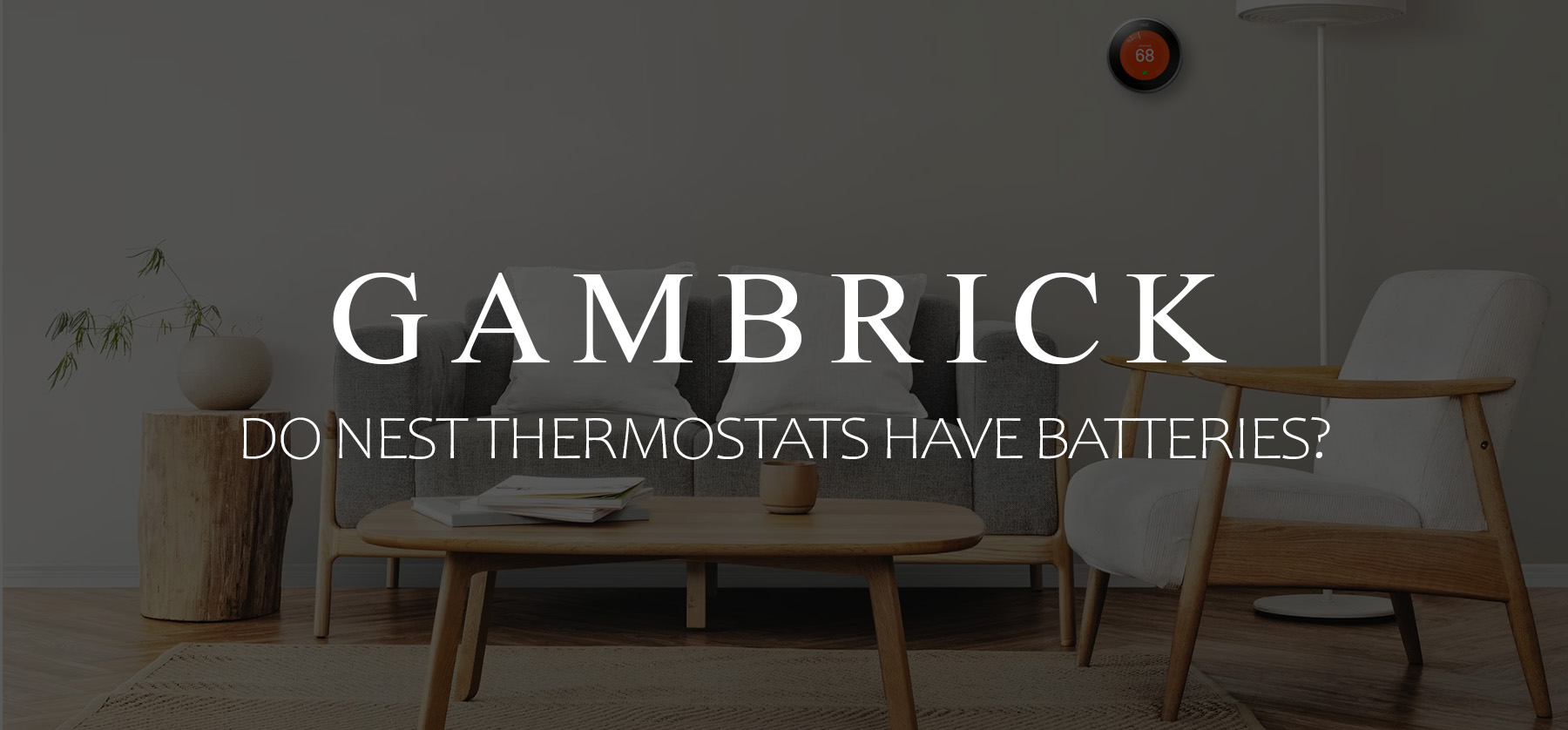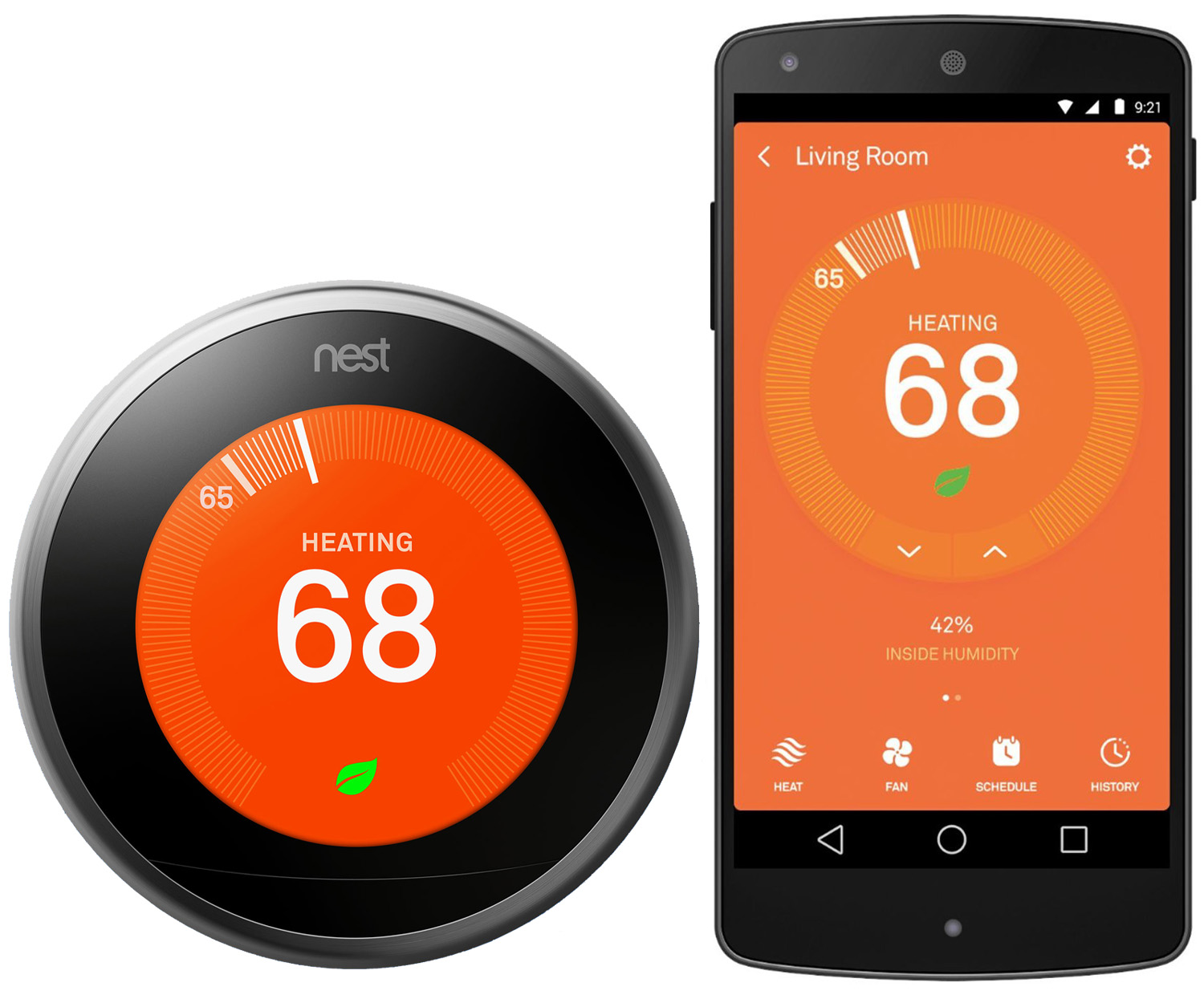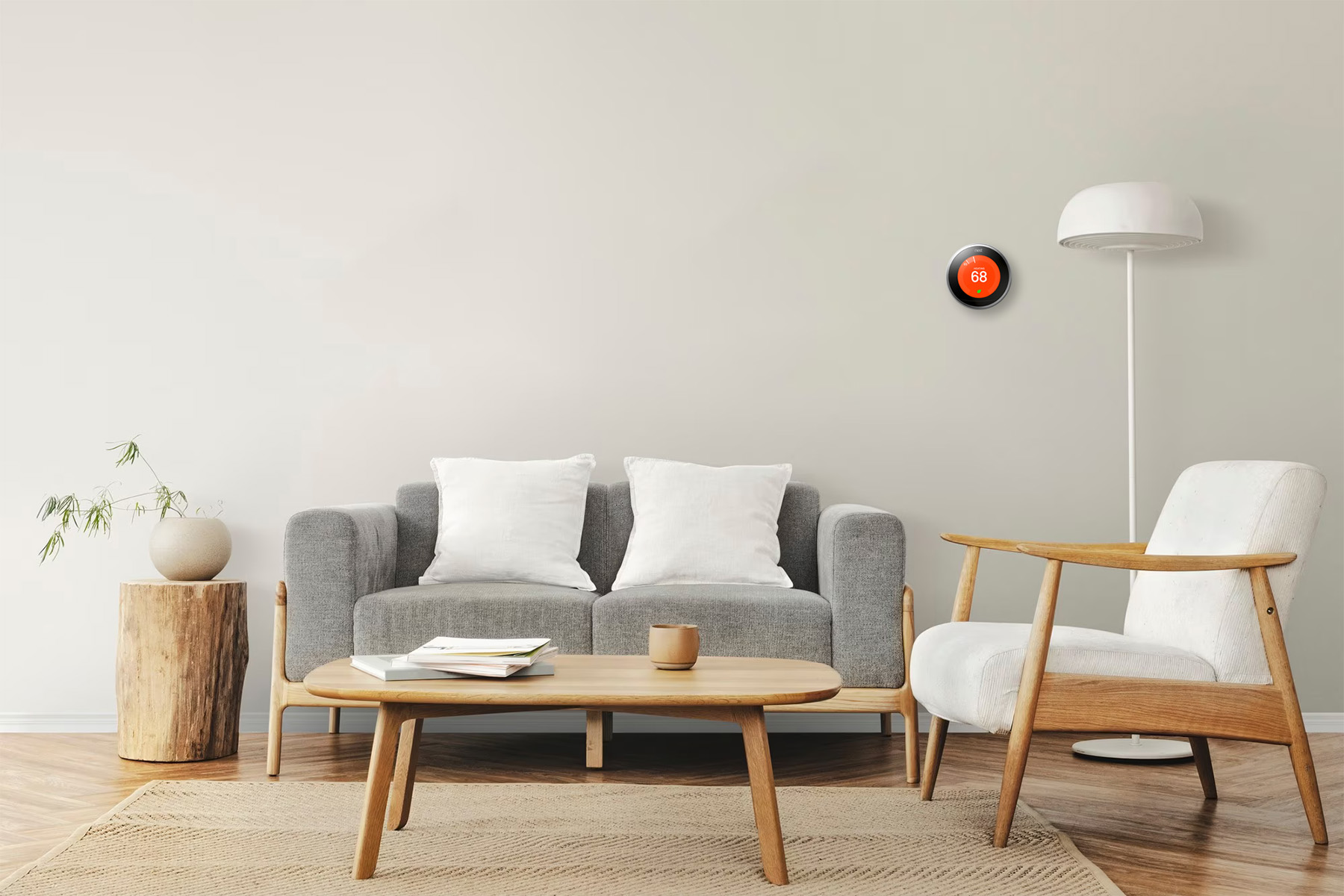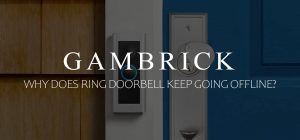Do Nest Thermostats Have Batteries?
Nest Thermostat receives power from a low voltage wire connected to your HVAC system with 2 AAA alkaline batteries as a backup. Nest Learning Thermostats are also powered by the HVAC system but have a built in rechargeable lithium-ion battery. If you have the standard Google Nest Thermostat, you need to change the backup batteries when they eventually go dead. Even if you’re not using the batteries they slowly lose power over time. It’s best to keep a pair of AAA batteries on hand for when that happens. The Google Nest App lets you check the power at any time. A Google Nest Learning Thermostat does not require replacement batteries as the backup lithium-ion battery supply is always being recharged.
Nest thermostats are a popular brand of smart thermostats that allow you to control the temperature of your home from your smartphone or tablet. They have a sleek design and intuitive user interface with a variety of sensors that monitor and adjust the temperature in your home automatically. This makes them effective and energy efficient.
Nest Thermostats are very low maintenance but you should do the following to make sure the system is working properly:
- Keep your thermostat clean
- Update the software
- Check the batteries, sensors and wiring
- Make sure the hardwire running to the HVAC system is supplying enough power
Nest Thermostats use very little power, averaging just 6V to 7V when the system is running. That equates to less than 1 kWh/month on average. And they can adjust the temperature inside your home automatically. Such low power usage and automatic temperature controls makes them a very energy efficient thermostat.
Nest Learning Thermostat Lithium-Ion Battery
Regular Nest Thermostats are powered primarily by a low voltage wire running to the HVAC system. They have 2 AAA batteries as a backup if primary power goes down. Nest learning Thermostats are powered by the same low voltage wire running to the HVAC system, but they also have a built in rechargeable Lithium-Ion battery instead of replaceable AAA batteries.
The Nest’s Lithium-Ion battery is constantly being recharged by the primary power source. You can check it’s power level in the Nest App or at the device.
If you go into your Nest Learning Thermostat “Battery” settings, you’ll find the current voltage of your thermostat’s internal rechargeable battery. The voltage will fluctuate, but it should be higher than 3.6V when it’s charging normally.
If your thermostat isn’t receiving enough power to charge the battery and it falls below 3.6V, it will turn off WiFi, delay software updates, and disable the screen to preserve battery charge and delay shutting down completely.
Nest Learning Thermostat needs the following:
- 3.7V is required to install a software update.
- 3.6V is required for the display to turn on when you approach.
If your Nest Learning Thermostat isn’t receiving enough power, check your wiring and HVAC system to find out why the power supply is so low.
Nest Learning Thermostat Voc, Vin & Iin
Voc, Vin, and Iin measure the electrical current sent to your thermostat by the system wires.
Below are the ranges that the Voc, Vin and Iin should stay in during normal operation. There are different Vin and lin values if you have a common or C wire in your thermostat:
If there isn’t a C wire in your thermostat:
- Voc: 29 to 42V
- Vin:
- 29 to 42V when your system is not running
- 6 to 7V when your system is running
- Iin: 20 to 40 mA
If there is a C wire in your thermostat:
- Voc: 29 to 42V
- Vin: 29 to 42V
- Iin: 100 or 200 mA
Troubleshooting power issues
If the above power specs are outside of their normal range, you may need to troubleshoot to find the issue. For example, if your Nest Thermostat won’t turn on and is unresponsive, or you see a blinking red light at the top of the Thermostat’s screen, it may not be getting enough power to charge its battery.
If you have issues regarding power being sent to your Nest Thermostat, I recommend calling a Professional. They’ll be able to detect the exact amount of power running to the Nest and diagnose why it’s too low.
How Nest Thermostats Work
Nest Thermostats connect to your home’s HVAC (heating, ventilation, and air conditioning) system through low voltage wiring. They’re compatible with most standard HVAC systems, including furnace and air conditioner units.
The thermostat is installed by connecting it to the HVAC system and linking it to your home’s WiFi network. Once connected, you can use the Nest app on your smartphone or tablet to remotely control the temperature of your home.
- Nest thermostats use a variety of sensors to monitor the temperature inside your home. These sensors allow the thermostat to learn your preferences and automatically adjust the temperature to your desired settings. The thermostat also uses the information it gathers to create a schedule of your heating and cooling habits. This automatically keeps your home comfortable and improves energy efficiency.
- Nest thermostats can also be controlled by voice commands through a smart assistant like Google Assistant or Amazon Alexa.
- Some models include a feature called “Farsight” which uses a motion sensor to detect when someone is near the thermostat. When someone approaches it will display the temperature or time on the thermostat’s screen.
Nest Thermostats primarily use power from your HVAC system to operate, but they also have a battery backup which varies based on the model.
- Regular Nest Thermostats have a 2 AAA battery backup.
- Nest Learning Thermostats have a built in rechargeable Lithium-Ion battery which stays charged by the HVAC system.
The Role Of Batteries In A Nest Thermostat
Nest thermostats primarily run on power supplied by the HVAC system, but they also have a battery backup in case the power goes out. Regular Nest Thermostats have 2 AAA batteries as a backup. But Nest learning Thermostats have a built in rechargeable Lithium-Ion battery backup. The role of a battery backup is to ensure the thermostat can continue to function if the main power source is lost.
- The Lithium-Ion battery is designed to last for several hours and will automatically charge itself when the main power is restored.
- Lithium-Ion battery power can be checked on the thermostat screen or through the Nest app. If the battery level is low, it will alert you to charge it.
- AAA batteries are not recharged by the Nest. However, you can use rechargeable AAA batteries in a Nest.
Replacing the Lithium-Ion battery is easy to do. To access it, simply remove the thermostat’s faceplate.
- The battery backup used by Nest Learning Thermostat is a standard CR123A lithium-ion battery.
Some of the newer Nest Thermostat models like Nest Thermostat E and Nest Thermostat 3rd Gen do not have a user-replaceable battery. The battery is permanent and built into the device.
All Nest thermostats are designed to work with your HVAC system. They require a hard-wire connection to your home’s HVAC system as a primary power source. The battery is only a backup power source and is not intended to be a primary power source for the thermostat.
If your home loses power, the Nest Thermostat will automatically switch to battery power. However, if your HVAC system is also not working, your Nest Thermostat will not be able to control the temperature. In this case the battery power is only used to retain the thermostat’s settings and schedule until power is restored.
How To Maintain A Nest Thermostat
A Nest Thermostats is easy to use and requires very little maintenance. However proper maintenance is important for keeping your Nest Thermostat in good working order.
Here are a few tips for maintaining your Nest Thermostat:
- Keep the thermostat clean: Dust and debris can accumulate on the thermostat’s sensors, which can affect its ability to accurately measure the temperature inside your home. To clean your thermostat, use a soft dry cloth to gently wipe the faceplate and sensors.
- Update the software: Nest occasionally releases software updates that can improve the performance of your thermostat. To check for updates, open the Nest app and go to the settings menu.
- Check the batteries: Nest Learning Thermostats have a built-in rechargeable lithium-ion battery that serves as a backup power source in case of a power outage. Regular Nest Thermostats use 2 AAA batteries as a backup. Check the battery level regularly and replace them if necessary.
- Inspect the wiring: Make sure the wiring for your Nest Thermostat is properly connected. If you notice any loose or frayed wires, contact a professional to fix the issue.
- Check the HVAC system: Regularly check and maintain your HVAC system to ensure that it’s working properly. This helps your Nest thermostat control the temperature inside your home more effectively.
- Check the sensor: Nest thermostat uses various sensors to monitor the temperature inside your home. If the thermostat is not working correctly, it may be caused by the sensor being blocked, dirty or malfunctioning.
By following these tips, you can help ensure that your Nest Thermostat continues to work properly and provides accurate temperature control for your home.
Do You Have To Change The Battery In Nest Thermostat?
A Nest Thermostat uses 2 standard 1.5V AAA alkaline batteries that you’ll need to replace when they get low. When the batteries get low, you’ll get notification on the thermostat and in the Home app. You can check the battery power level on the thermostat or in the Home app at any time. Nest Learning Thermostat uses a built in rechargeable Lithium-Ion battery as a backup. It charges automatically by your HVAC system and doesn’t normally need to be changed unless there’s a problem.
Some of the newer Nest thermostat models like Nest Thermostat E and Nest Thermostat 3rd Gen do not have a user-replaceable battery.
How Long Does A Nest Thermostat Battery Last?
A regular Nest Thermostat uses 2 AAA batteries as a backup which last 12 to 24 months on average depending on the type of battery you use. This is assuming there are no power outages during that time. If there’s a power outage and the Nest runs on battery backup, how long the batteries last depends on the length of the outage.
What Happens When Nest Thermostat Runs Out Of Batteries?
If the primary power source from the HVAC system is down and your Nest is running on backup battery power, it will turn completely off once the batteries die. You’ll no longer be able to control the HVAC system.
Does Nest Thermostat Need To Be Plugged In?
No, Nest Thermostats does not need to be plugged in. It’s primary power source is low voltage wiring running to the HVAC system. In addition, it has either a built in rechargeable Lithium-Ion battery or 2 AAA batteries as a backup for when primary power goes down. Nest Thermostats do not plug into a standard outlet for power.
Are Nest Thermostat Batteries Rechargeable?
Nest Learning Thermostat uses a rechargeable Lithium-Ion battery as a backup for when primary power goes down. The battery is built in and constantly being charged by the primary power source. Regular Nest Thermostats use 2 AAA batteries as a backup which eventually need replacement or recharging when they get low. However, recharging of AAA batteries is not done by the Nest, rather, you must use rechargeable AAA batteries which have their own separate charger.
Summary: Do Nest Thermostats Have Batteries?
Nest Thermostat receives power from a low voltage wire connected to your HVAC system with 2 AAA alkaline batteries as a backup. Nest Learning Thermostats are also powered by the HVAC system but have a built in rechargeable lithium-ion battery. If you have the standard Google Nest Thermostat, you need to change the backup batteries when they eventually go dead. Even if you’re not using the batteries they slowly lose power over time. It’s best to keep a pair of AAA batteries on hand for when that happens. The Google Nest App lets you check the power at any time. A Google Nest Learning Thermostat does not require replacement batteries as the backup lithium-ion battery supply is always being recharged.
Nest thermostats are a popular brand of smart thermostats that allow you to control the temperature of your home from your smartphone or tablet. They have a sleek design and intuitive user interface with a variety of sensors that monitor and adjust the temperature in your home automatically. This makes them effective and energy efficient.
Nest Thermostats are very low maintenance but you should do the following to make sure the system is working properly:
- Keep your thermostat clean
- Update the software
- Check the batteries, sensors and wiring
- Make sure the hardwire running to the HVAC system is supplying enough power
Nest Thermostats use very little power, averaging just 6V to 7V when the system is running. That equates to less than 1 kWh/month on average. And they can adjust the temperature inside your home automatically. Such low power usage and automatic temperature controls makes them a very energy efficient thermostat.
If you have any questions about a Nest Thermostat, email any time.























